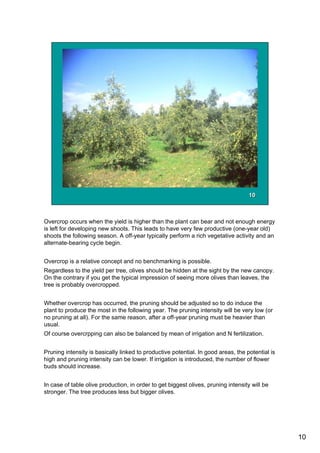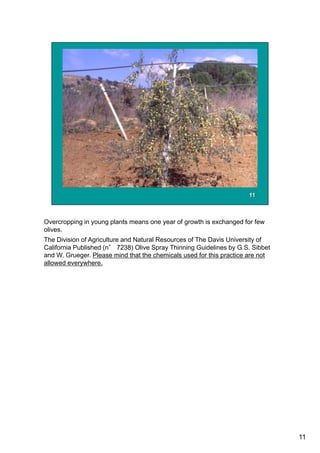Olive Pruning 2 Li
- 1. This section is the second part of a basic presentation on pruning used for different occasions and audiences. It will not make anyone a perfect pruner â pruning cannot be learned indoor only and require practicing. This presentation presents my vision of what pruning means and its economic and technical consequences. This presentation was intended as the fist part of a course to be accomplished in the grove grove. 1
- 2. Tips for field-activity. Observing and comparing the work of two different expert pruners is very interesting. This allows considering different approaches. Valuable information derives from marking some of the most interesting and discussed shoots (and recording the related discussions) and organizing a trip to the same grove after six months for considering how the plant responded to the treatment. 2
- 3. 3
- 4. This drawings depicts the blooming (and fruiting) and new sprouting along an olive shoot. In the first season, new born shoots basically perform a pure elongation. In the following spring, blooming occurs while some of the buds generate new sprouts. The shoot is now grown long but is still very tender; it bows under the weight of the fruits. The secondary shoots keep on growing and the next year will perform as the primary one. This sprouting lengthening -fruiting-bending mechanism is a continuous process. sprouting-lengthening fruiting bending process It is the basic cycle of the fruiting shoot. But is it real stuff or just a didactical scheme? Do real plants actually behave like that? 4
- 5. This cycle is present all aver the productive canopy. It is the way the tree renovates its productive shoots. The wise pruner will remove those shoots that have already bore fruit and keep the ones which are to bloom. The canopy in the p py photo was so severely reduced only because the tree was to y y be transplanted. 5
- 6. Actually, not all shoots behave like this. Some are more vigorous than normal and require more time to become productive. Normally, internal vertical shoots are sterile and grow sturdily during the first and the second year. By then, many lateral shoots have appeared and a rich blooming occurs. These fruiting secondary shoots develop accordingly to the bouncy curve described before. 6
- 7. The canopy of this branch was thinned out. Most of old shoots were patiently pruned and the light can penetrate the canopy. Probably the pruner mostly operated on little shoots and did very few big cuts. 7
- 8. This branch was pruned with a very different style. This not necessarily involving a pruning intensity heavier than in the previous case; the pruner did only few big cuts and neglected the little shoots. 8
- 9. Which one is the best? It is hard to answer: it just a matter of different way of operating and there are endless possibilities in the between. If the second pruner (right) had faced the branch in the upper photo, he would probably have cut only the lower of the two major secondary branches and happily moved to another side of the tree. The first pruner (left) needed much more time than the second. I tried to measure the productive consequences of the two different way of pruning. I did not noticed much difference and I guess this was basically due to a ff different pruning intensity rather than to the pruning way. If the lower photo pruner is faster and the yield is the same, which pruning would you adopt? Which one would better fit a combing device? Which a hooked shaker? The pruning intensity is a basic concept. It determines the amount of one-year buds remaining on the tree and consequently the production potential. Pruning too much leads to not fully realizing the productive potential. Pruning too less can be equally inconvenient. 9
- 10. Overcrop occurs when the yield is higher than the plant can bear and not enough energy is left for developing new shoots. This leads to have very few productive (one-year old) f f f ( ) shoots the following season. A off-year typically perform a rich vegetative activity and an alternate-bearing cycle begin. Overcrop is a relative concept and no benchmarking is possible. Regardless to the yield per tree, olives should be hidden at the sight by the new canopy. On the contrary if y g the typical impression of seeing more olives than leaves, the y you get yp p g tree is probably overcropped. Whether overcrop has occurred, the pruning should be adjusted so to do induce the plant to produce the most in the following year. The pruning intensity will be very low (or no pruning at all). For the same reason, after a off-year pruning must be heavier than usual. Of course overcrpping can also be balanced by mean of irrigation and N fertilization fertilization. Pruning intensity is basically linked to productive potential. In good areas, the potential is high and pruning intensity can be lower. If irrigation is introduced, the number of flower buds should increase. In case of table olive production, in order to get biggest olives, pruning intensity will be stronger. The tree produces less but bigger olives. 10
- 11. Overcropping in young plants means one year of growth is exchanged for few olives. The Division of Agriculture and Natural Resources of The Davis University of California Published (n° 7238) Olive Spray Thinning Guidelines by G.S. Sibbet and W. Grueger. Please mind that the chemicals used for this practice are not allowed everywhere. 11
- 12. Pruning olive trees has long been considered a peculiar winter activity. There is a reason f that: before the plant begins t grow again at spring, undesired shoots for th t b f th l t b i to i t i d i d h t are removed so that most new sprouts develop according to the wished shape. Should it be possible to measure up the olive tree growing activity, we would record two main peaks: one at spring, the second at fall. In fact, in Mediterranean climate, summer is so torrid that plants slow down growing. In the Middle East region plants grow even more in winter than in summer. In other regions the summer is quite fresh and the rest takes place in winter winter. In most olive growing regions, the olive activity depicts a two main bumps (spring and fall) curve. For mature productive trees the vegetation activity is mostly concentrated at spring, since in autumn grate energy is allocated in oil synthesis (being the oil a hyper-caloric substance, this is an energy demanding process). Therefore, wisely tradition sets the pruning before spring. On the contrary for young not yet fruiting plants, the fall bump is at least as high as the spring one ( in many cases even higher). Therefore pruning could be conveniently shared into two phases at the end of winter and after full summer. 12
- 13. 13













